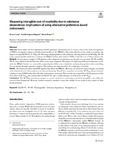Mostrar o rexistro simple do ítem
Measuring Intangible Cost-Of-Morbidity Due to Substance Dependence: Implications of Using Alternative Preference-Based Instruments
| dc.contributor.author | Casal, Bruno | |
| dc.contributor.author | Rodríguez-Míguez, Eva | |
| dc.contributor.author | Rivera, Berta | |
| dc.date.accessioned | 2024-01-12T16:27:33Z | |
| dc.date.issued | 2020 | |
| dc.identifier.citation | Casal, B., Rodríguez-Míguez, E. & Rivera, B. Measuring intangible cost-of-morbidity due to substance dependence: implications of using alternative preference-based instruments. Eur J Health Econ 21, 1039–1048 (2020). https://doi.org/10.1007/s10198-020-01196-7 | es_ES |
| dc.identifier.issn | 1618-7601 | |
| dc.identifier.issn | 1618-7598 | |
| dc.identifier.uri | http://hdl.handle.net/2183/34886 | |
| dc.description.abstract | [Abstract] Objective: Drug and/or alcohol dependence (DAD) generates substantial costs to society. One of the main consequences of DAD is its negative impact on health-related quality of life (HRQoL). The main objective of this study is to analyse the impact of using EQ-5D-5L, SF-6DSG (SF-6D using standard-gamble as the preference-eliciting method) and SF-6DPG (SF-6D using a paired-gamble method), to estimate the HRQoL burden, attributable to DAD, within the cost-of-illness framework. Methods: A convenience sample of 109 patients with a diagnosis of substance use disorder was recruited. SF-6D and EQ-5D-5L were administered and then the utility scores were computed. The impact of employing different instruments to estimate the HRQoL burden was assessed by comparing the utility scores of patients and general population after controlling for sex and age through regression analysis. The analysis was reproduced for two subgroups of severity. Results: All instruments detect that DAD significantly affects the HRQoL. However, the estimated impact changes, according to the instrument used, whose pattern varies by severity group. Nonetheless, regardless of severity, SF-6DPG always estimates a higher or equal DAD burden than the other instruments considered. These results are compatible with the presence of the floor effect in SF-6DSG, the ceiling effect in EQ-ED-5L, and a smaller presence of both biases in SF-6DPG. Conclusions: The SF-6DPG instrument emerges as a good candidate to avoid under-estimating intangible costs within the cost-of-illness framework. However, further research is needed to assess the validity of our results in the context of other health problems. | es_ES |
| dc.description.sponsorship | Funding: Ministerio de Sanidad, Servicios Sociales e Igualdad (2013I027), Ministerio de Ciencia, Innovación y Universidades (RTI2018-099403-B-100) | es_ES |
| dc.description.sponsorship | Ministerio de Sanidad, Servicios Sociales e Igualdad; 2013I027 | es_ES |
| dc.language.iso | eng | es_ES |
| dc.publisher | Springer | es_ES |
| dc.relation | info: eu-repo/grantAgreement/AEI/Plan Estatal de Investigación Científica y Técnica y de Innovación 2017-2020/RTI2018-099403-B-I00/ES/ESTUDIOS EMPIRICOS DE ECONOMIA INDUSTRIAL Y ECONOMIA DE LA SALUD. APLICACIONES CON DATOS MICROECONOMICOS | es_ES |
| dc.relation.uri | https://doi.org/10.1007/s10198-020-01196-7 | es_ES |
| dc.rights | © Springer | es_ES |
| dc.subject | EQ-5D-5L | es_ES |
| dc.subject | SF-6D | es_ES |
| dc.subject | Paired-gamble | es_ES |
| dc.subject | Substance dependence | es_ES |
| dc.subject | Intangible cost | es_ES |
| dc.title | Measuring Intangible Cost-Of-Morbidity Due to Substance Dependence: Implications of Using Alternative Preference-Based Instruments | es_ES |
| dc.type | info:eu-repo/semantics/article | es_ES |
| dc.rights.access | info:eu-repo/semantics/embargoedAccess | es_ES |
| dc.date.embargoEndDate | 9999-99-99 | es_ES |
| dc.date.embargoLift | 10007-06-07 | |
| UDC.journalTitle | The European Journal of Health Economics | es_ES |
| UDC.volume | 21 | es_ES |
| UDC.startPage | 1039 | es_ES |
| UDC.endPage | 1048 | es_ES |
| dc.identifier.doi | https://doi.org/10.1007/s10198-020-01196-7 |






